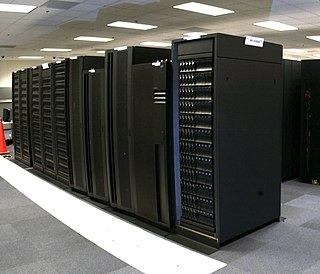Related Research Articles
Internet Small Computer Systems Interface or iSCSI is an Internet Protocol-based storage networking standard for linking data storage facilities. iSCSI provides block-level access to storage devices by carrying SCSI commands over a TCP/IP network. iSCSI facilitates data transfers over intranets and to manage storage over long distances. It can be used to transmit data over local area networks (LANs), wide area networks (WANs), or the Internet and can enable location-independent data storage and retrieval.

NetWare is a discontinued computer network operating system developed by Novell, Inc. It initially used cooperative multitasking to run various services on a personal computer, using the IPX network protocol.

Network Attached Storage or more recently Network Application Server (NAS) is a file-level computer data storage server connected to a computer network providing data access to a heterogeneous group of clients. The term "NAS" can refer to both the technology and systems involved, or a specialized device built for such functionality.

Clariion is a discontinued SAN disk array manufactured and sold by EMC Corporation, it occupied the entry-level and mid-range of EMC's SAN disk array products. In 2011, EMC introduced the EMC VNX Series, designed to replace both the Clariion and Celerra products.
In computing, the Global File System 2 or GFS2 is a shared-disk file system for Linux computer clusters. GFS2 allows all members of a cluster to have direct concurrent access to the same shared block storage, in contrast to distributed file systems which distribute data throughout the cluster. GFS2 can also be used as a local file system on a single computer.
HPE Integrity Servers is a series of server computers produced by Hewlett Packard Enterprise since 2003, based on the Itanium processor. The Integrity brand name was inherited by HP from Tandem Computers via Compaq.
Lustre is a type of parallel distributed file system, generally used for large-scale cluster computing. The name Lustre is a portmanteau word derived from Linux and cluster. Lustre file system software is available under the GNU General Public License and provides high performance file systems for computer clusters ranging in size from small workgroup clusters to large-scale, multi-site systems. Since June 2005, Lustre has consistently been used by at least half of the top ten, and more than 60 of the top 100 fastest supercomputers in the world, including the world's No. 1 ranked TOP500 supercomputer in November 2022, Frontier, as well as previous top supercomputers such as Fugaku, Titan and Sequoia.

SUSE is a Luxembourgish multinational open-source software company that develops and sells Linux products to business customers. Founded in 1992, it was the first company to market Linux for enterprise. It is the developer of SUSE Linux Enterprise and the primary sponsor of the community-supported openSUSE Linux distribution project. While the openSUSE "Tumbleweed" variation is an upstream distribution for both the "Leap" variation and SUSE Linux Enterprise distribution, its branded "Leap" variation is part of a direct upgrade path to the enterprise version, which effectively makes openSUSE Leap a non-commercial version of its enterprise product.
The IBM SAN Volume Controller (SVC) is a block storage virtualization appliance that belongs to the IBM System Storage product family. SVC implements an indirection, or "virtualization", layer in a Fibre Channel storage area network (SAN).
Gluster Inc. was a software company that provided an open source platform for scale-out public and private cloud storage. The company was privately funded and headquartered in Sunnyvale, California, with an engineering center in Bangalore, India. Gluster was funded by Nexus Venture Partners and Index Ventures. Gluster was acquired by Red Hat on October 7, 2011.

The IBM Storage product portfolio includes disk, flash, tape, NAS storage products, storage software and services. IBM's approach is to focus on data management.
A clustered file system (CFS) is a file system which is shared by being simultaneously mounted on multiple servers. There are several approaches to clustering, most of which do not employ a clustered file system. Clustered file systems can provide features like location-independent addressing and redundancy which improve reliability or reduce the complexity of the other parts of the cluster. Parallel file systems are a type of clustered file system that spread data across multiple storage nodes, usually for redundancy or performance.
Microsoft SQL Server is a proprietary relational database management system developed by Microsoft. As a database server, it is a software product with the primary function of storing and retrieving data as requested by other software applications—which may run either on the same computer or on another computer across a network. Microsoft markets at least a dozen different editions of Microsoft SQL Server, aimed at different audiences and for workloads ranging from small single-machine applications to large Internet-facing applications with many concurrent users.
Ceph is a free and open-source software-defined storage platform that provides object storage, block storage, and file storage built on a common distributed cluster foundation. Ceph provides completely distributed operation without a single point of failure and scalability to the exabyte level, and is freely available. Since version 12 (Luminous), Ceph does not rely on any other conventional filesystem and directly manages HDDs and SSDs with its own storage backend BlueStore and can expose a POSIX filesystem.
This is a comparison of online backup services.
Blue Whale Clustered file system (BWFS) is a shared disk file system made by Tianjin Zhongke Blue Whale Information Technologies Company in China.

SCST is a GPL licensed SCSI target software stack. The design goals of this software stack are high performance, high reliability, strict conformance to existing SCSI standards, being easy to extend and easy to use. SCST does not only support multiple SCSI protocols but also supports multiple local storage interfaces and also storage drivers implemented in user-space via the scst_user driver.
Enterprise Storage OS, also known as ESOS, is a Linux distribution that serves as a block-level storage server in a storage area network (SAN). ESOS is composed of open-source software projects that are required for a Linux distribution and several proprietary build and install time options. The SCST project is the core component of ESOS; it provides the back-end storage functionality.
ONTAP or Data ONTAP or Clustered Data ONTAP (cDOT) or Data ONTAP 7-Mode is NetApp's proprietary operating system used in storage disk arrays such as NetApp FAS and AFF, ONTAP Select, and Cloud Volumes ONTAP. With the release of version 9.0, NetApp decided to simplify the Data ONTAP name and removed the word "Data" from it, removed the 7-Mode image, therefore, ONTAP 9 is the successor of Clustered Data ONTAP 8.
References
- ↑ "Release Notes | SUSE Enterprise Storage 7".
- ↑ SUSE Enterprise Storage 2 and iSCSI
- ↑ SES 2.0 and iSCSI White Paper
- ↑ SES 2 release announcements
- ↑ Cache Tiering
- ↑ SES 5
- ↑ SES 5 Release Note
- ↑ SES 5 presentation
- ↑ "SUSE Enterprise Storage 6 Now Available". 24 June 2019.
- ↑ "SUSE Enterprise Storage 7 - new horizons". 28 October 2020.
- ↑ "Product Support Lifecycle | SUSE".
- ↑ SUSE Enterprise Storage 1.0 download
- ↑ SuseCon press release
- ↑ SUSECON